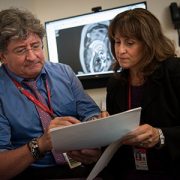Panel: Significant Zika risks linger for pregnant women and developing fetuses in US

The threat from Zika “is not over. It is just beginning for the families who are affected by this,” says Roberta L. DeBiasi, M.D., M.S., chief of the Division of Pediatric Infectious Diseases and co-director of the Congenital Zika Virus Program at Children’s National Health System.
The Zika virus epidemic may have fallen off the radar for many media outlets, but significant risks continue to linger for pregnant women and developing fetuses, a panel of experts told staff working for U.S. Congressional leaders.
“The threat of this virus is real, and the threat continues,” Margaret Honein, Ph.D., M.P.H., of the Centers for Disease Control and Prevention’s (CDC) pregnancy and birth defects task force, said during the July 13 briefing held in the Russell Senate Office Building.
Dr. Honein told about 100 attendees that more than 200 Zika-affected babies have been born in the United States suffering from serious birth defects, such as rigid joints, inconsolable distress that causes them to cry continuously and difficulties swallowing. Some of these infants experience seizures that cause further brain damage.
Predicting what Zika will do next in the United States is very difficult, Dr. Honein said, adding that local outbreaks could occur “at any time.” A map she displayed showed Zika’s impact in shades of blue, with Zika infections documented in nearly every state and the highest number of infections – and deepest shade of blue – for California, Florida and Texas.
The threat from Zika “is not over. It is just beginning for the families who are affected by this,” agreed Roberta L. DeBiasi, M.D., M.S., chief of the Division of Pediatric Infectious Diseases and co-director of the Congenital Zika Virus Program at Children’s National Health System.
Since Children’s National launched its Zika program in May 2016, the multidisciplinary team has consulted on 65 mother-fetus/infant pairs, Dr. DeBiasi said. Because in utero Zika infection can result in a wide range of side effects, the Children’s team includes pediatric infectious diseases experts, fetal/neonatal neurologists to consult on seizures, audiologists to assess hearing, physical therapists and orthopaedists to contend with limb contractures, pulmonologists to relieve breathing problems and ophthalmologists to diagnose and treat vision disorders – among other specialists.
“You really need a program that has all of these areas of expertise available for a family,” Dr. DeBiasi told attendees. “It is not possible for a family to organize 27 different appointments if you have a child with these needs.”
Children’s Zika experts also collaborate with researchers in Colombia to gauge the ability of magnetic resonance imaging to produce earlier Zika diagnoses, to assess the role of viral load as biomarkers and to document Zika’s long-term impact on children’s neurodevelopment. The Colombia study has enrolled an additional 85 women/infant pairs.
In one presentation slide, Dr. DeBiasi showed sharp magnetic resonance imaging scans from their research study of a fetal brain at 18 and 22 weeks gestation that indicated clear abnormalities, including abnormal cortical folding. Ultrasound images taken at the exact same time points did not detect these abnormalities, she said.
Asked for advice by an attendee whose clinic treats women who regularly travel between California and Mexico, Dr. DeBiasi underscored the fact that Zika infection poses a risk to developing fetuses even if the pregnant woman has no symptoms of infection. “Whether or not they’re symptomatic, the risk is the same. It’s hard for people to understand that. That is No. 1,” she said.
Another challenge is for women who scrupulously follow the CDC’s guidance on lowering their infection risk while traveling. Upon return, those women may be unaware that they could still be exposed to Zika through unprotected sex with their partner who also has travelled, for as long as six months after travel.










